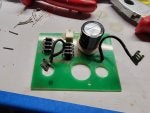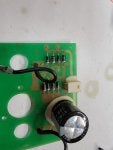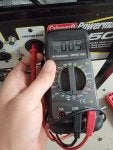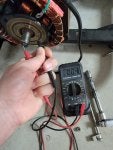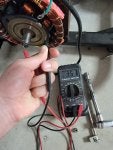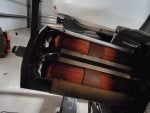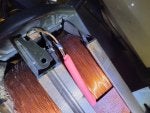Hi Forum,
I have a Problem with my Powermate 6250 Generator. I usually pull it out every 4 month and let it run for a while. Last time I used it to vacuum my car and all the sudden it stopped producing power.
I checked the brushes and they are not brand new, but also not worn. I can measure the length tonight.
I also removed the black end cap and saw that the brushed are just connected to a few diods and capacitor. I measured the diods and they are fine. I also measured the resistance of the rotor and believe that it's also fine. I can't really say anything to the capacitor, but it looked ok, not blown or so.
Now, when I used the vacuum it felt like, the vacuum cleaner started to run slower and slower while it was connected to the Generator. The RPM of the Generator where constant.
I found this website and followed the repolarizing section. Fixing Electrical Problems in Coleman Powermate Generators
It makes a good sparc, but still does not produce power. If I connect a jig saw to the outlet and switch it on while I am repolarizing the Generator and leave the battery connected to the brushes the jig saw starts to slowly moving. In a way as it would run on 10% of the full speed the jig saw can do. So I think my Generator is technically ok, but I don't know how to get it working again.
![Image]()
I have a Problem with my Powermate 6250 Generator. I usually pull it out every 4 month and let it run for a while. Last time I used it to vacuum my car and all the sudden it stopped producing power.
I checked the brushes and they are not brand new, but also not worn. I can measure the length tonight.
I also removed the black end cap and saw that the brushed are just connected to a few diods and capacitor. I measured the diods and they are fine. I also measured the resistance of the rotor and believe that it's also fine. I can't really say anything to the capacitor, but it looked ok, not blown or so.
Now, when I used the vacuum it felt like, the vacuum cleaner started to run slower and slower while it was connected to the Generator. The RPM of the Generator where constant.
I found this website and followed the repolarizing section. Fixing Electrical Problems in Coleman Powermate Generators
It makes a good sparc, but still does not produce power. If I connect a jig saw to the outlet and switch it on while I am repolarizing the Generator and leave the battery connected to the brushes the jig saw starts to slowly moving. In a way as it would run on 10% of the full speed the jig saw can do. So I think my Generator is technically ok, but I don't know how to get it working again.










